

The primary purpose of the patellar reflex – the stretch reflex of the quadriceps femoris muscle – is to prevent excessive stretching of the quadriceps. Beyond simple reflexes with integrating centers in the spinal cord, more complex reflexes have integration centers in the brainstem or even in the cerebrum.Ī stretch reflex is a type of muscle reflex, which protects muscle against increases in length that can tear and damage muscle fibers. They involve interneurons, found in the CNS, which further process stimulus and output information. Polysynaptic reflexes are more complex, but also more common. This is the simplest reflex arc, and the integrating center is in the spinal cord.

This type of reflex is a “withdrawal” reflex and is monosynaptic, meaning only one synapse has to be crossed between the sensory neuron and the motor neuron. The sensory neuron synapses with a motor neuron, which innervates an effector tissue, such as skeletal muscle in order to pull away from painful stimuli.

The sensory neuron detects stimuli and sends a signal towards the CNS. Reflexes require a minimum of two neurons, a sensory neuron (input) and a motor neuron (output) (see Figure 1).
The effector cell responds to efferent impulses (for example, by contracting, if the effector is a muscle fiber).īecause integrating center processing may occur at the level of the spinal cord rather than requiring impulses to travel to the brain, reflex responses have a relatively short path length and, thus, a quick reaction time compared to voluntary or conscious body movements. A motor, or efferent, neuron sends a nerve impulse along an efferent pathway from the integration center to an effector cell. An integration center consists of one or more synapses in the CNS (typically the spinal cord) where the incoming information and outgoing response are integrated. The sensory, or afferent, neuron sends a nerve impulse through an afferent pathway to the central nervous system. A receptor, and independent sensory cell, or an ending of a sensory neuron, reacts to a stimulus (e.g., a stretch receptor). The reflex arc typically consists of five components: Examples are shivering in response to low core body temperature or withdrawing your hand from a hot stove when temperature and pain receptors in your hand register the stimulus.Ī reflex arc refers to the neural pathway that a nerve impulse follows. \)Ī reflex is an involuntary (automatic) response to stimulus that quickly returns the body to homeostasis.







 0 kommentar(er)
0 kommentar(er)
